Motor Learning
1/71
Earn XP
Description and Tags
KIN 4571 Final Exam
Name | Mastery | Learn | Test | Matching | Spaced |
|---|
No study sessions yet.
72 Terms
Adaptation
the ability to modify motor output in response to changing sensory input
could be conscious or unconscious
Ex. throwing with prism goggles on that shifts your vision 30 degrees to the right
Condition-associative
motor response to conditioned stimulus, pairing stimulus with behavior
adaptive and automatic
Ex. Pavlov’s dog salivates to a bell ringing
Condition-nonassociative
motor response to conditioned stimulus, not pairing stimulus with behavior
habituation
sensitization
Habituation
suppression of a response to a stimulus (ex. wearing clothing)
Sensitization
accentuation of a response to a stimulus (ex. pain)
Motor skill learning
formation of new movement sequences to gain speed, precision, accuracy, and/or efficiency
Learning
acquiring a motor skill
Memory
retaining a motor skill
learning and memory
needed to learn motor skills
Early-cognitive phase
following the concepts and facts, require concentration
brain stimulation → language centers
cortical control
The early-cognitive phase requires more ________
Intermediate phase
trial and error, attempt different strategies
brain stimulation → motor/sensorimotor association areas
feedforward and feedback
updated by motor/sensorimotor association areas to refine motor performance
Late-autonomous phase
mastery
brain stimulation → basal ganglia
subcortical control
The late-autonomous phase requires more ________
Broca’s
spoken word (unable to speak with damage)
Wernicke’s
language/speech comprehension
Primary auditory cortex
located in the temporal lobe, below the lateral fissure
NOT a part of the language areas but involved with them
Arcuate fasciculus
connects Broca’s and Wernicke’s areas
helps monitor what you say (language) and repeat what other people say
links spoken and comprehension areas
Broca’s area
What is the blue?
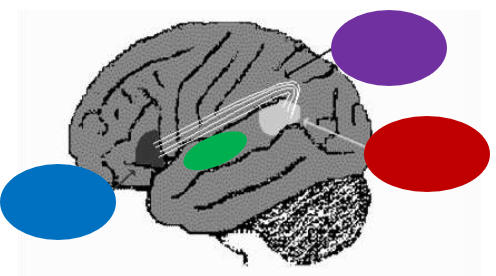
Arcuate fasciculus
What is the purple?
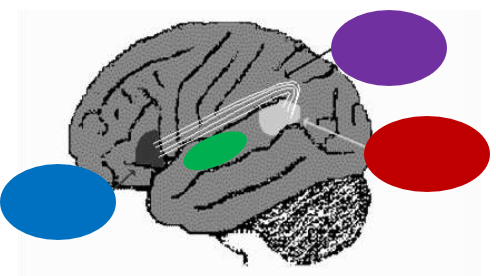
Wernicke’s area
What is the red?
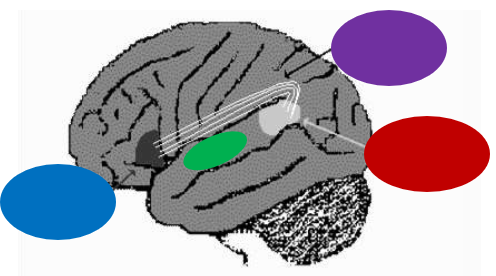
Primary auditory cortex
What is the green?
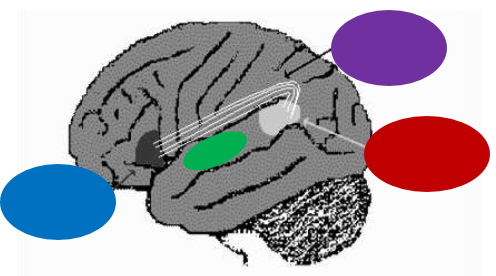
parallel; separate
Declarative and procedural memories are ________ but _________ learning systems
Declarative (semantic) memory
acquisition of facts and concepts
involve limbic system (medial temporal areas)
hippocampus
Hippocampus
involves information storage, but is not the storage site for memory; part of the limbic system
hippocampus
If the _________ is damaged, you will lose the ability to store new memory, but you could recall old memory.
Procedural memory
learn motor skills and acquire habits
involves sensorimotor, SMA, PM, cerebellum, parietal regions, prefrontal, and basal ganglia
specific; habit
Declarative memory is _______ while procedural is _________
hippocampus
What is the blue part?
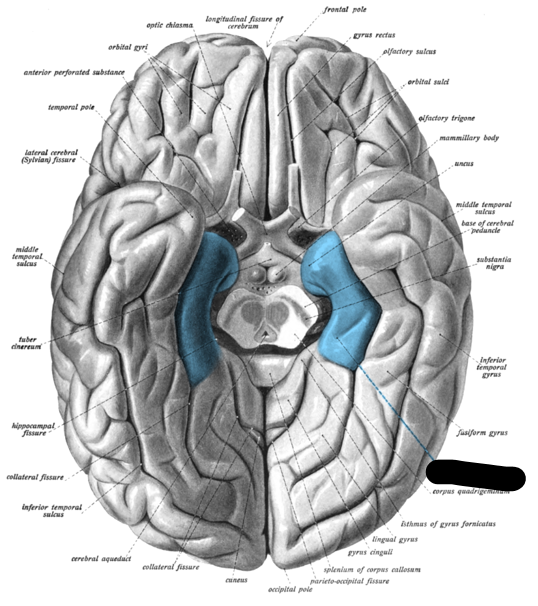
Alzheimer’s
What disease caused the right portion?
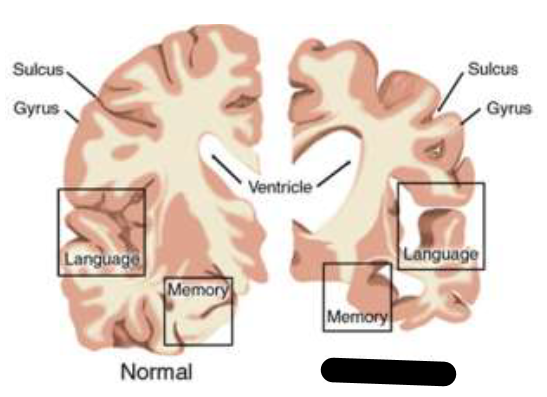
increased; decreased
People with Alzheimer’s have _________ ventricle size and _________ cerebral cortex, memory, and language areas.
Sensory afferent information
important for learning new skills and the adaptability of learned skills
Examples:
animals with legions of dorsal roots (sensory afferents) → impair learning new movements
patients with peripheral neuropathy could drive their old care but not new cars → previously learned motor programs are retained, but there is poor adaptability
the importance of this might differ based on type of learning, sensory modality involved, and stage of learning phase
less
Late autonomous requires _______ sensory feedback
more
Early cognitive phase requires _______ sensory feedback
faster
________ movements = less sensory, more feedforward
slower
________ movements = more sensory, more feedback
Spinal cord
changes in this structure’s motor neurons have been found in response to up- and/or down-regulation of certain reflexes (learning)
Down-regulation
Up-regulation
H-reflex
Down-regulation
shift away from action potential threshold, making it harder to trigger reflex
Up-regulation
fewer and smaller inhibitory synaptic terminals, making it easier to trigger reflex
H-reflex
the summation of excitatory and inhibitory influences on motor neurons
higher
_________ H-reflex makes it easier to trigger reflex
lower
_________ H-reflex makes it harder to trigger reflex
Cerebellum
adaptive learning (occurs in multiple sites in nervous system, not just this)
sequencing for multi-joint movements
Basal ganglia
putamen
important for transferring skills into procedural memory and perform pre-learned movement
motivation of learning
Putamen
important for transferring skills into procedural memory and perform pre-learned movement
Cerebral cortex
primary location for declarative and procedural memory
Includes:
parietal areas (and thalamus)
primary motor (MI)
premotor area
supplementary motor area (SMA)
prefrontal areas and some cingulate gyrus
Parietal areas (and thalamus)
integrate sensory information for learning new complex motor task
feedforward
Parietal areas and thalamus updates __________
Primary motor (MI)
preparation and execution of movement
encode force and direction
Premotor area
new movement sequences
sensory-guided movements
Supplementary motor area (SMA)
pre-learned sequence
Prefrontal areas and some cingulate gyrus
direct attention and motivational aspects
more involved in the early-cognitive phase than the late-autonomous phase
prefrontal areas
directs attention
some cingulate gyrus
motivation
Early skill acquisition
language areas
parietal areas
thalamus
Actual performance
sensorimotor cortex
SMA
premotor
associated parietal areas
part of the cerebellum
Motor skill acquisition
increased activity in parts of the basal ganglia and less activity in the cortical association areas
Activity-dependent synaptic plasticity
forming synapses
the more you do it, the better you do
with practice, strengthen synapses which makes the movement easier to perform
Long-term potentiation
move the baseline closer to the threshold
the closer, the better
with practice, strengthen synapses which makes the movement easier to perform
Changes in the excitability of the post synaptic neuron
associated with long-term potentiation
greater excitability makes the movement easier to perform
long-term potentiation needs this since it explains how long-term potentiation works
Growth of new connections
new pathways for motor learning
form new connections and pathways
increase
If you _________ the excitability of post synaptic neurons, it will make the movement easier to perform
decrease
If you _________ the excitability of post synaptic neurons, it will make the movement harder to perform
Performance
What is the y-axis?
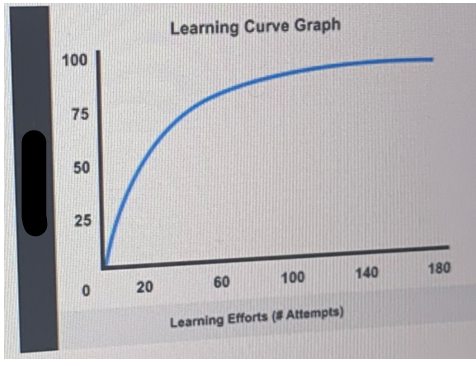
Error
What is the y-axis?
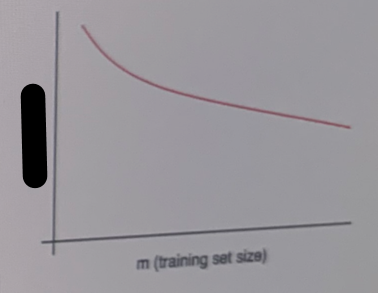
Early-cognitive phase
following the concepts and facts
greater involvement of Wernicke’s area
Intermediate phase
attempt different strategies
trial and error
greater involvement of motor/sensorimotor association areas
Late-autonomous phase
greater basal ganglia involvement
more subcortical involvement
language, parietal, thalamus
main structure(s) involved in the early-cognitive phase
premotor
main structure(s) involved in the intermediate phase
basal ganglia
main structure(s) involved in the late-autonomous phase